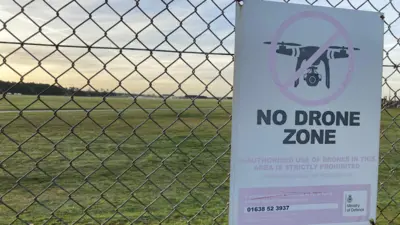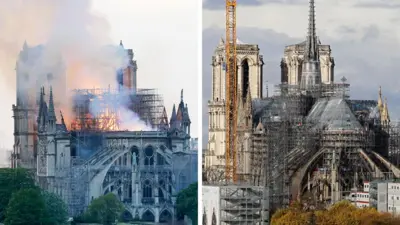We've updated our Privacy and Cookies Policy
We've made some important changes to our Privacy and Cookies Policy and we want you to know what this means for you and your data.
Climate change: One man's fight to save a California tree
Image source, Cody Petterson
- Author, Georgina Rannard
- Role, ґуПуґ«ГЅ News
After a huge wildfire killed a forest in San Diego, California, in 2002, Cody Petterson set his heart on replanting the trees.
As a child, he had happily played and hiked among these statuesque conifers, which provide shelter to black bears and black-tailed deer. By the age of 37, he wanted to do his bit to conserve and repair the land.
But in the six years since he began, , which scientists link to global warming, and 650 of Cody's 750 seedlings died. struck a chord with thousands of people on social media when it was posted on Earth Day, in April.
Image source, Cody Petterson
Top Stories
"I think of all the love I've put into saving that forest, all the years, all the thousands of hours, all the thought, and worry, and hope, and faith," he wrote. "I felt despair for the world I've known and loved."
'Early indicator of climate change'
Globally, human activity is putting one million species are at risk of extinction, as nature declines at unprecedented speed, the UN said last week.
In California, the effects of climate change are ubiquitous - , earlier springs and less reliable rainfall.
The tree Cody planted, the Bigcone Douglas-fir, is native to southern California and does not grow outside the state. But now experts believe its time is limited in San Diego.
Instead, it will probably move to higher elevations in search of wetter conditions.
Image source, Michael Kauffmann
Top Stories
The species is an early indicator for the impact of climate change, says for the US Forest Service. The tree's decline in San Diego is a "harbinger for the next 50-100 years".
For Cody, an anthropologist and environmentalist, it's a devastating result after years of difficult work on his 300 acres (1.2 sq km) of land in the Volcan mountain range.
One-man crusade
When he bought the property with his wife, in 2013, he realised the trees' seed bank had also been destroyed in the 2002 Pines Fire, making it difficult for the conifers to re-establish alone. After securing government funding to replant the forest, he began what could be called a one-man crusade.
"I read everything I could about reforestation, botany, ecology, soil. I collected acorns, thousands of cones, and seeds," Cody told ґуПуґ«ГЅ News.
"To my wife's chagrin, I filled a third of the refrigerator with bags of seeds in various stages of stratification and germination. I filled the backyard with potted seedlings."
Eventually, he began to plant the seedlings out on the mountain.
"I planted every which way I could, learning something new each time, year after year," he said. "The first year I planted in the open, the seedlings baked. Next, I planted in the shade - and they baked."
When gophers and rabbits ate the fledging trees, he built cages to protect them.
from December 2011 to March 2019, according to the US Drought Monitor. Cody was watering the seedlings across the large area every two to three weeks.
Image source, Cody Petterson
"Winter rains are good but there's no snow-melt anymore and a winter rain doesn't help a seedling survive in October when there hasn't been a drop of rain in eight months," he said. "The second half of 2017 was the driest on record here.
"I've planted hundreds over the years, and filled my patio and yard. I've lost too many to count but I can somehow remember the moment I first saw each one had dried out."
Scientists have found that snowy mountain winters are being "squeezed" shorter by climate change in California.
Ecologist Michael Kauffmann says that climate change is "definitely" affecting the tree's ability to survive.
"The worst of it is the lower elevations. Trees have always moved in search of good growing conditions," he said. "But right now, because of the acceleration of climate change, the spots favoured by Bigcone Douglas-fir on lower elevation, south-facing slopes are drying out - and the trees just aren't making it."
Image source, Michael Kauffmann
Other factors are also contributing to the area's changing environment.
Invasive species such as grasses, which humans help to spread, compete with native species for moisture, nutrients and sunlight. The , which is causing more frequent and more ferocious wildfires, is a particular cause for concern for forestry.
Despite the fact the Bigcone Douglas-fir can regenerate, even flourish, after it burns, they cannot survive high intensity fires, according to the US Forest Service.
Top Stories
Facing the shrinking tree range, Cody says he has accepted he must give up his dream of growing a new Bigcone forest. But he struggles to think how to explain it to his children, who are three and six.
Image source, Cody Petterson
"I thought of this photo we took a couple of years ago, sitting in front of all our hundreds of seedlings - so happy," he said. "How do I tell them that I don't know what to do with the 600 seedlings in the backyard? That there's no place left in the world for these trees they've grown up with?"
Cody has begun to focus more time on environmental activism and lobbying but he hasn't given up his forest dream entirely.
This time he's pinning his hopes on another native but more drought-tolerant conifer - the Coulter pine.
.
.
Top Stories
More to explore
Most read
Content is not available








